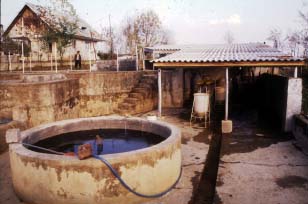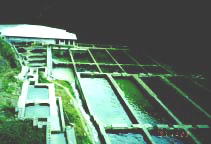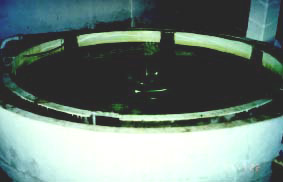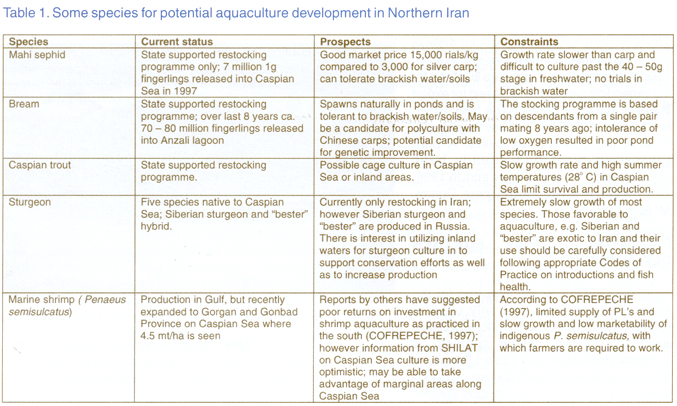Reproductive and seed rearing technologies and infrastructure has been disseminated to private farmers in an effort at privatization and strengthening of the sector. Aquaculture has since expanded to culture of food fish in raceways (trout) and ponds (cyprinids). Other species are also being targeted for future culture. Development projects on the farming of penaeid shrimp (Peneaus semisulcatus and P. indicus) in the Gulf region and along the southeastern area of the Caspian Sea are currently underway. The IRI have also initiated projects to evaluate the feasibility of culturing Artemia cyst, grouper, pearl oyster, and aquatic plants.
Current status of aquaculture production
The Government has been successful in its efforts to raise aquaculture output and this is reflected in the overall expansion rate of the sector at 8.2 %/yr during 1990-1996. To date, five species contribute to aquaculture output in the IRI (Figure 1). In 1996, production amounted to 30,000 mt, valued at US$ 306.6 million. Production of the major species, rainbow trout, Onchorincus mykiss, silver carp, Aristichthys molitrix, and bighead, A. nobilis, increased at 27, 11 and 7 %/yr between 1991 and1996. The Chinese carps: silver carp, grass carp, (Ctenopharyngodon idella) and bighead carp, and common carp dominated production. In 1996, the two groups accounted for 93% (28,000 mt) of reported aquaculture production. Following the introduction of Chinese carps in the 70s, there has been a shift from traditional common carp monoculture to polyculture of Chinese and common carp. The increasing production of silver carp reflects the higher stocking ratio of this phytoplankton feeder in the polyculture system despite its lower retail market price (R2,500- 3,000/kg in 1995) (3,000 Rials = 1 US$) compared to grass carp (R5,000-6,000 in 1995).
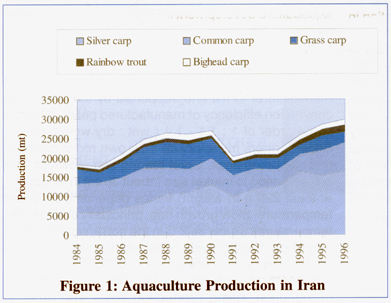
Incentives for expanding aquaculture
Iran is actively pursuing a holistic approach for aquaculture development, building on one of its key strengths--technology for mass artificial propagation of seed and infrastructure for restocking inland and coastal waters. To promote aquaculture as an independent economic activity, the IRI has taken several initial steps to encourage private sector involvement. These include:
• making the private sector solely responsible for fingerling production for ongrowing,
• providing low interest loans,
• subsidizing feed ingredients for feed production,
• providing low price fingerlings from state hatcheries,
• granting twenty-year tax exemption for farms,
• providing low priced or free land with service, such as roads and canals for shrimp farms, and
• mounting effective public promotion initiatives to increase fish consumption, particularly in the Central region of the IRI, where fish eating habits are not well established.
These recent initiatives of the Government have proved successful in attracting private investment in both the seed production and ongrowing segments of the sector. In 1996, around 20 private cyprinid and 10 private trout fingerling production hatcheries were operational. In case of rainbow trout, 80 private ongrowing farms were operational in 12 provinces. Between 1992 and 1996, the area under rainbow trout production increased from 80,000 to 166,000 m2 (raceway area) and production increased from 775 to 1,900 mt.
Current situation and capacity
Production of major species groups
The culture of carps, trouts and marine shrimp currently form the basis of Iranian aquaculture.
Carps
Carps are primary farmed in three main provinces: Gilan, Mazandaran and Khuzestan. Production of carp seed for grow-out by private industry is now primarily done by the private sector. Carp broodstock selection is usually based on head-size, color, and gill structure (surface and shape of filter) and adults are usually used for 3-4 years and then replaced. A key factor in the successful transfer of seed production to the private sector was the switch from the Hungarian method of seed production using small incubators and small spawning tanks in which
